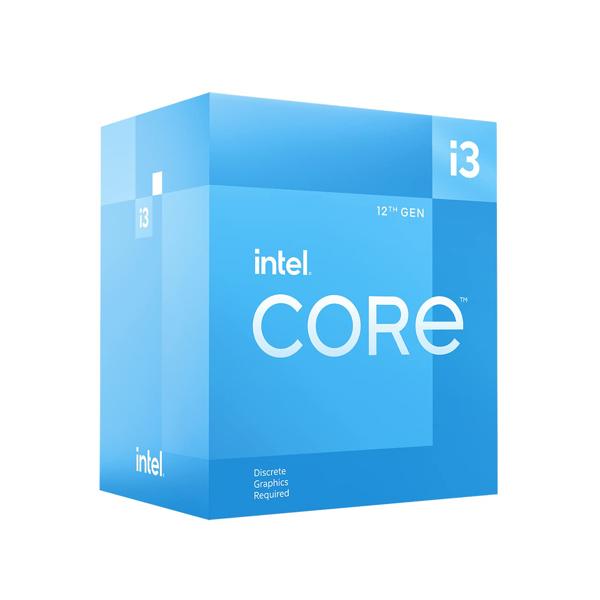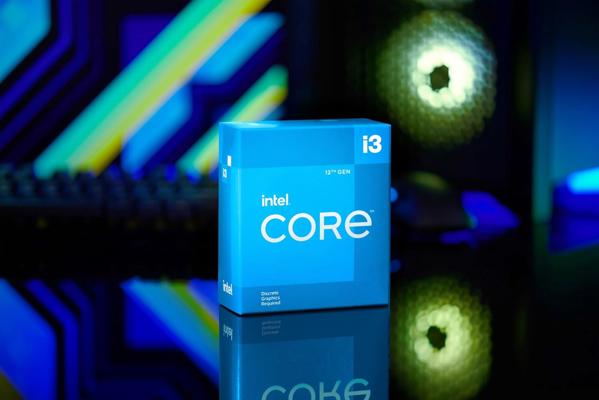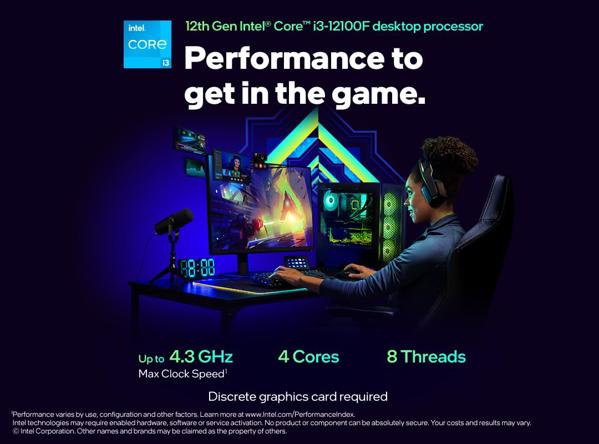





INTEL GEN 12TH I-3 12100F
Intel's 12th generation processors, known as Alder Lake, introduce a hybrid architecture with performance and efficiency cores. This design boosts multitasking and gaming performance while supporting DDR5 memory and advanced technologies.
Features
The Intel Core i3-12100F is a budget-friendly, entry-level processor from Intel’s 12th Gen Alder Lake series, designed for users who need a solid performer for everyday computing tasks but without the high cost of more powerful models. This quad-core processor (4 cores and 8 threads) is ideal for general usage such as web browsing, office tasks, multitasking, and light gaming. The 12100F variant, like its sibling, the 12100, does not include integrated graphics, meaning it requires a discrete GPU for any graphical output.
Core Specifications:
Core Configuration:
- Cores: 4 Performance cores (P-cores)
- Threads: 8 threads (due to Hyper-Threading technology)
Clock Speeds:
- Base Clock: 2.3 GHz
- Max Turbo Frequency: Up to 4.3 GHz
Cache:
- L3 Cache: 12 MB Intel Smart Cache
- L2 Cache: 1 MB (shared across cores)
Thermal Design Power (TDP):
- Base TDP: 58W
- Max Turbo Power: 89W
Socket: LGA 1700
Key Features:
Quad-Core, 8-Thread Performance:
The i3-12100F features 4 performance cores (P-cores) that are designed to handle single-threaded workloads with high efficiency. Thanks to Intel’s Hyper-Threading Technology, the processor can handle 8 threads simultaneously, providing a noticeable performance boost during multitasking and light parallel processing workloads. This makes it an excellent option for budget-conscious users who need decent performance for general applications, including web browsing, light photo/video editing, and office tasks.
Max Turbo Boost Up to 4.3 GHz:
The 12100F can reach 4.3 GHz on its turbo boost frequency, giving it an edge in single-core performance during tasks like gaming, running legacy applications, or performing high-intensity actions like compiling code. While it doesn’t feature Intel’s Turbo Boost Max Technology 3.0, the boost frequency is still enough to handle most everyday tasks and many light gaming scenarios.
Intel UHD 730 Graphics (Excluding the F Variant):
The i3-12100F does not include integrated graphics, unlike the regular i3-12100 model, which is equipped with Intel UHD 730 graphics. As such, users of the i3-12100F will need to pair it with a discrete GPU if graphical tasks like gaming, media streaming, or video output are required. This helps to keep the processor price lower while appealing to users who already have a discrete graphics card.
Intel 7 Process Technology:
Built on Intel’s 7nm SuperFin process technology, the i3-12100F offers improved power efficiency and performance over older process nodes. This enables the processor to deliver better performance per watt and keep power consumption at a lower level, making it suitable for budget systems or users looking to minimize energy consumption.
Intel Smart Cache:
With 12 MB of Intel Smart Cache, the i3-12100F is capable of storing frequently accessed data for faster retrieval. This increases the processor’s overall responsiveness and performance in multi-tasking or repetitive tasks, where data needs to be accessed frequently, such as running applications, opening files, or web browsing.
Performance and Use Cases:
Light Gaming:
While the i3-12100F doesn’t feature integrated graphics, it can still handle 1080p gaming when paired with a discrete GPU, such as an NVIDIA GeForce GTX 1650 or an AMD Radeon RX 6500 XT. It is suitable for casual gaming and can play games like Fortnite, League of Legends, and Minecraft smoothly at medium settings. The 12100F provides decent performance for gamers who don’t need the most powerful CPU and already have or intend to purchase a separate GPU.
General Computing:
The i3-12100F excels in general computing tasks such as browsing the web, using office applications (e.g., Microsoft Office), handling email, and watching videos. For users who need a responsive system for typical daily tasks, this processor will perform without any noticeable lag, even when running multiple applications simultaneously.
Office Productivity:
For users who need a solid CPU for productivity applications, the i3-12100F offers more than enough power. Whether it's working with documents, spreadsheets, or presentations, the processor handles multi-threaded productivity workloads well. This makes it an excellent option for office workers, students, or home office users who need a reliable, no-frills solution.
Multitasking:
Thanks to its 4 cores and 8 threads, the i3-12100F can multitask with relative ease. Opening multiple browser tabs, running productivity software in parallel, and streaming media are all well within the capabilities of this chip. While not as capable as high-end CPUs, it handles everyday multitasking without significant slowdowns.
Media Consumption:
While it doesn’t include integrated graphics, users who pair the i3-12100F with a discrete GPU will be able to watch 4K video, stream content, and use media applications like Netflix, YouTube, and Spotify without issue. As long as you have a graphics card, the 12100F is more than adequate for media consumption tasks.
Power Efficiency:
Thermal Design Power (TDP): The i3-12100F has a base TDP of 58W, which is relatively low for a quad-core processor. It’s energy-efficient, making it a good option for users who want to reduce power consumption while still having a capable CPU. This power efficiency also means less strain on cooling systems, making the 12100F a great choice for small form factor builds or quiet systems.
Max Turbo Power (89W): Under peak load, the 12100F can draw up to 89W, but its overall power consumption remains lower than higher-tier models. This means that users don’t need to worry about excessive power requirements, even when performing more demanding tasks.
Cooling:
The relatively low power consumption and TDP of the i3-12100F mean that even a basic air cooler (such as the stock Intel cooler) will suffice to keep temperatures under control. Users looking for a quieter system or reduced overall heat output can pair the processor with a low-profile or quiet cooling solution.
Specifications
| TOTAL NUMBER OF CORE | 4 |
|---|---|
| TOTAL NUMBER OF PERFORMANCE CORES | 4 |
| TOTAL NUMBER OF EFFICIENT CORES | 0 |
| TOTAL NUMBER OF THREADS | 8 |
| MAX RAM MEMORY SUPPORT | 128 GB |
| MOTHERBOARD SUPPORT | 600 / 700 SERIES |
| MEMORY SUPPORT | DDR-4 UPTO 3200 MT/S, DDR-5 UPTO 4800 MT/S |
| MAX MEMORY BANDWIDTH | 76.8 GB/S |
| EFFICIENT CORE BASE FREQUENCY | 3.30 GHZ |
| EFFICIENT CORE MAX TURBO FREQUENCY | 3.30 GHZ |
| PERFORMANCE CORE BASE FREQUENCY | 4.30 GHZ |
| PERFORMANCE CORE MAX TURBO FREQUENCY | 4.30 GHZ |
| SOCKET TYPE | LGA 1700 |
| LITHOGRAPHY | 7NM |
| TOTAL CACHE | 12 MB |
| TOTAL L2 CACHE | 5 MB |
| THERMAL JUNCTION | 100 |
| PCIe REVISION | 4 |
| MAX NUMBER OF PCIe LANES | 20 |
| PROCESSOR TDP | 89 W |
| INBUILT GRAPHIC PROCESSING UNIT | NO |